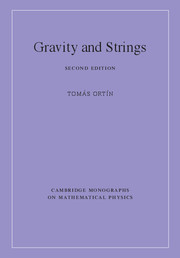Book contents
- Frontmatter
- Dedication
- Contents
- Preface to the second edition
- Preface to the first edition
- Part I Introduction to gravity and supergravity
- 1 Differential geometry
- 2 Symmetries and Noether's theorems
- 3 A perturbative introduction to general relativity
- 4 Action principles for gravity
- 5 Pure N = 1, 2, d = 4 supergravities
- 6 Matter-coupled N = 1, d = 4 supergravity
- 7 Matter-coupled N = 2, d = 4 supergravity
- 8 A generic description of all the N ≥ 2, d = 4 SUEGRAs
- 9 Matter-coupled N = 1, d = 5 supergravity
- 10 Conserved charges in general relativity
- Part II Gravitating Point-Particles
- Part III Gravitating extended objects of string theory
- Appendix A Lie groups, symmetric spaces, and Yang–Mills fields
- Appendix B The irreducible, non-symmetric Riemannian spaces of special holonomy
- Appendix C Miscellanea on the symplectic group
- Appendix D Gamma matrices and spinors
- Appendix E Kähler geometry
- Appendix F Special Kähler geometry
- Appendix G Quaternionic-Kähler geometry
- Appendix H Real special geometry
- Appendix I The generic scalar manifolds of N ≥ 2, d = 4 SUEGRAs
- Appendix J Gauging isometries of non-linear σ-models
- Appendix K n-spheres
- Appendix L Palatini's identity
- Appendix M Conformal rescalings
- Appendix N Connections and curvature components
- Appendix O The harmonic operator on ℝ3 × S1
- References
- Index
5 - Pure N = 1, 2, d = 4 supergravities
from Part I - Introduction to gravity and supergravity
Published online by Cambridge University Press: 05 April 2015
- Frontmatter
- Dedication
- Contents
- Preface to the second edition
- Preface to the first edition
- Part I Introduction to gravity and supergravity
- 1 Differential geometry
- 2 Symmetries and Noether's theorems
- 3 A perturbative introduction to general relativity
- 4 Action principles for gravity
- 5 Pure N = 1, 2, d = 4 supergravities
- 6 Matter-coupled N = 1, d = 4 supergravity
- 7 Matter-coupled N = 2, d = 4 supergravity
- 8 A generic description of all the N ≥ 2, d = 4 SUEGRAs
- 9 Matter-coupled N = 1, d = 5 supergravity
- 10 Conserved charges in general relativity
- Part II Gravitating Point-Particles
- Part III Gravitating extended objects of string theory
- Appendix A Lie groups, symmetric spaces, and Yang–Mills fields
- Appendix B The irreducible, non-symmetric Riemannian spaces of special holonomy
- Appendix C Miscellanea on the symplectic group
- Appendix D Gamma matrices and spinors
- Appendix E Kähler geometry
- Appendix F Special Kähler geometry
- Appendix G Quaternionic-Kähler geometry
- Appendix H Real special geometry
- Appendix I The generic scalar manifolds of N ≥ 2, d = 4 SUEGRAs
- Appendix J Gauging isometries of non-linear σ-models
- Appendix K n-spheres
- Appendix L Palatini's identity
- Appendix M Conformal rescalings
- Appendix N Connections and curvature components
- Appendix O The harmonic operator on ℝ3 × S1
- References
- Index
Summary
In the previous chapter, we introduced increasingly complex theories of gravity, starting from GR, to accommodate fermions, and we saw that the generalizations of GR that we had to use could be thought of as gauge theories of the symmetries of flat spacetime.
A very important development of the past few decades has been the discovery of supersymmetry and its application to the theory of fundamental particles and interactions. This symmetry relating bosons and fermions can be understood as the generalization of the Poincaré or AdS groups, which are the symmetries of our background spacetime to the super-Poincaré or super-AdS (super-)groups, which are the symmetries of our background superspacetime, a generalization of standard spacetime that has fermionic coordinates.
It is natural to construct generalizations of the standard gravity theories that can be understood as gauge theories of the (super-)symmetries of the background (vacuum) superspacetime. These generalizations are the supergravity (SUGRA) theories. Given that the kind of fermions that we can have depends critically on the spacetime dimension, the SUGRA theories that we can construct also depend critically on the spacetime dimension. Furthermore, we can extend the standard bosonic spacetime in different ways by including more than one (N) set of fermionic coordinates. This gives rise to additional supersymmetries relating them and, therefore, to supersymmetric field theories and SUGRA theories with N supersymmetries. The latter are also known as extended SUGRAs (SUEGRAs). The SUEGRAs can be further extended by coupling them to supersymmetric matter (matter fields that fill complete representations of the supersymmetry algebra) and they can be deformed by introducing new couplings among the fields depending on new parameters. The main deformation procedure is that of gauging global symmetries, explained in Section 2.5, but it is not the only one: some supergravities also admit the so-called massive deformations, the main example being Romans' massive N = 2A, d = 10 theory [1083], which is reviewed in Section 22.2. All the possible deformations can, apparently, be taken into account by the embedding tensor formalism, reviewed in Section 2.7.
- Type
- Chapter
- Information
- Gravity and Strings , pp. 175 - 198Publisher: Cambridge University PressPrint publication year: 2015



